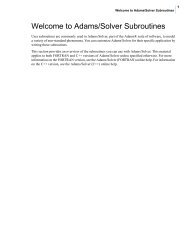Create successful ePaper yourself
Turn your PDF publications into a flip-book with our unique Google optimized e-Paper software.
<strong>ICAM</strong> <strong>Virtual</strong> <strong>Machine</strong> ® <strong>Virtual</strong> <strong>Machine</strong> Reference, Model Customization<br />
The Dialog Editor, The Dialog Template Editor<br />
� Text: Use the Text control to add text to your dialog. Properties include the position and<br />
the text itself. You can use line breaks in the text input field to show multi-line text in the<br />
dialog. The text control is automatically sized to the required text width and height, although<br />
you may have to adjust the underlying window frame to fully see the text.<br />
� Frame: Use the Frame control to visually group related dialog controls. Properties include<br />
the text label that appears at the top-left corner of the frame, and the position and<br />
size of the frame.<br />
� Button: Use the Button control to create buttons, such as the OK and Cancel buttons.<br />
Properties include the text label that appears inside the button, the type of button, and the<br />
position and size of the button. Buttons with an “OK” type cause the dialog to close<br />
when they are pressed, returning the button label text (e.g., “OK”) as the return value to<br />
the $FDIALOG function, and all dialog macro variables set as shown in the dialog. Buttons<br />
with a “Cancel” type cause the dialog to close, returning the button label text (e.g.,<br />
“Cancel”) and leaving all dialog macro variables unchanged (but initialized if necessary).<br />
Buttons with a “Reset” type do not close the dialog; instead, they reset all controls to<br />
their initial state. Buttons with a “Call Dialog” type activate the specified dialog when<br />
pressed. A dialog called in this manner must reside in the same model or external file as<br />
its caller. You can choose to display (and return) any text you want for a button.<br />
� Edit-box: Use the Edit-box control to create a field that will optionally accept user-typed<br />
input. Properties include the default value for the field, its associated macro variable, the<br />
position and size of the edit-box field, and an “editable” flag indicating if the field can be<br />
changed by the user. When the $FDIALOG function is called, the edit-box field will initially<br />
be set to the macro variable value. The edit-box field will instead initially be set to<br />
the default value if the macro variable does not exist, or is $NULL, or is an empty string.<br />
The macro variable will be set to the contents of the edit-box field when an OK type button<br />
is pressed.<br />
� Check-box: Use the Check box control to accept logical True/False type input from the<br />
user. Properties include an optional text label that will appear to the right of the check<br />
box, the default set/clear state for the check box, its associated macro variable, and the<br />
position of the check box control. When the $FDIALOG function is called, the check box<br />
field will initially be set if: the variable is logical and is true; or the variable is numeric<br />
and non-zero; or the variable is text and is $TRUE. The check box field will initially be<br />
cleared if: the variable is logical and is false; or the variable is numeric and zero; or the<br />
variable is text and is $FALSE. The check box field will instead initially be set to the default<br />
value if the macro variable does not match any of the preceding, or does not exist, or<br />
is $NULL. The macro variable will be set to one of the true/false conditions, based on the<br />
macro variable type, when an OK type button is pressed.<br />
� Radio-button: Use the Radio-button control to present the user with a series of exclusive<br />
choices. Properties include an optional text label that will appear to the right of the radiobutton,<br />
an optional alternate return value, an initial state setting, its associated macro variable,<br />
and the position of the radio-button control. When a radio button is selected, the<br />
macro variable will be set by default to the label text. You can choose to return something<br />
different for the variable by specifying an alternate return value (e.g., a number).<br />
You must have two or more radio button controls sharing the same macro variable, and<br />
you can choose which one is the default state (setting the default state in one control<br />
clears this flag in the others). When the $FDIALOG function is called, the radio-button<br />
150 <strong>ICAM</strong> Technologies Corporation – Proprietary















